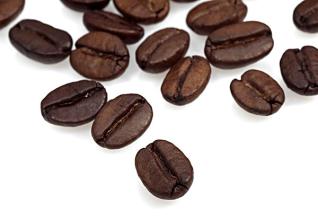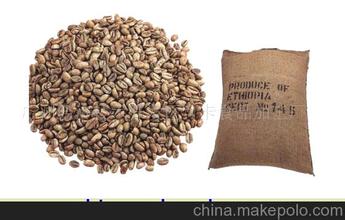Introduction to the production area of medium-roasted and deep-roasted coffee beans by taste treatment
Introduction to the production area of medium-roasted and deep-roasted coffee beans by taste treatment
Baking, as the name implies, is to provide heat to coffee beans, causing a series of chemical changes inside. First of all, the starch in raw beans will be converted into sugars and acids because of high temperature, while substances such as cellulose will be carbonized differently. Water and carbon dioxide evaporate, while proteins are converted into enzymes, which combine with the rest of the fat to form an oil film on the surface of coffee beans. Coffee beans swell when roasted, a bit like popcorn, and interestingly, coffee crackles during roasting, just like we use microwave popcorn. But because the skin on the surface of coffee beans is very tough, we usually don't see coffee beans crack like popcorn.
We often see that roasted coffee beans have different shades of color, on the one hand, this may be due to different types of individual coffee beans, and on the other hand, the main reason for this color difference is the different degree of roasting. In the most popular language, the degree of baking can be interpreted as the heat of baking. Take the most classic example of carbonated coffee, a French roasted coffee that is highly carbonized, dark brown and carbon black due to its deep roasting (either because of the high temperature during baking, or because of the long baking time, or both, depending on the situation). It is generally believed that carbonized coffee tastes bitter, which comes not only from caffeine, but also from carbonized coffee beans.
After World War II, coffee consumption in the United States increased year by year. In order to expand profits, roasters at that time became shallower and shallower. On the one hand, they could save man-hours and fuel costs, and on the other hand, they could reduce the weight loss ratio of cooked beans. At that time, coffee beans were in a hurry to be baked at the beginning of the explosion, and the weight loss ratio was less than 9%. Compared with the deep-baked beans baked after the second explosion, the weight loss ratio of shallow-baked beans was as high as 18%, and the profit of shallow-baked beans was at least 10% more than that of deep-baked beans. This is the trick used by unscrupulous people in the early days to make money by shallow baking, and even more seriously mixed with a large number of sun-dried beans. You can imagine how bad the coffee was at that time. No wonder it was ridiculed as "dishwashing water coffee". But consumers have long been accustomed to half-cooked sour bitter coffee, in order to be more palatable, had to add more water dilution, so light as water thin coffee, is the popular taste at that time. As long as caffeine is refreshing, no matter whether the coffee looks like sour or sour water. This is to blame that in order to preserve convenience during the war, the coffee allocated to frontline officers and soldiers by the US military was either very shallow roasted or instant coffee. These people enter society after retirement, naturally bringing the over-diluted taste of light coffee into the workplace. During the decade or two after the war, Folgers and the Hills Bros brothers, big American roasters, made great efforts to promote very lightly roasted canned coffee beans (powders). Over time, people did not know what fresh coffee was, and became accustomed to stale coffee, which tasted as good as sugar and cream. Rotten coffee is a hangover after the war, and it is also a phenomenon in Europe. Because the people are fully engaged in reconstruction, there is no way to talk about eating and drinking. This is why at that time, the American baking industry only wanted to enjoy huge profits and did not have the moral courage to denounce this unhealthy trend of "A money" in disguise.

Important Notice :
前街咖啡 FrontStreet Coffee has moved to new addredd:
FrontStreet Coffee Address: 315,Donghua East Road,GuangZhou
Tel:020 38364473
- Prev

Red Cherry Project Sidamo Coffee Bean Flavor description of taste variety producing area
Red Cherry Project Sidamo Coffee Bean Flavor description of the taste variety producing area in order to better let you know about the red cherry project, I have also done some homework to share with you. Operation Cherrie Red's Red Cherry Project (ORC) is a project to improve the quality of small-scale farms, mainly to encourage soybean farmers and surprise roasters, Trabocca, the largest coffee bean manufacturer in the Netherlands.
- Next

Description of taste and flavor of coffee beans treated by sun and water washing introduction to the origin of grinding scale varieties
Description of taste and flavor of coffee beans treated by sun and water washing varieties introduce the use of water washing and fermentation to remove peel, pulp and mucous membrane, and farms that use water washing must build washing ponds and be able to introduce an endless supply of live water. During the treatment, the mellow beans are put into the pool and passed back and forth, using the friction of the beans and the power of running water to make the coffee beans.
Related
- Guji coffee producing area of Guji, Ethiopia: Humbela, Shakiso, Wulaga
- What is the most expensive variety of Qiloso in BOP multi-variety group?
- How to store the coffee beans bought home?
- Why are Yemeni coffee beans so rare now?
- Ethiopian Sidamo all Red Fruit Sun Sun Santa Vini Coffee beans
- SOE is mostly sour? What does it mean? Is it a single bean? what's the difference between it and Italian blending?
- Is Italian coffee beans suitable for making hand-brewed coffee?
- How to choose coffee beans when making cold coffee? What kind of coffee beans are suitable for making cold coffee?
- Just entered the pit to make coffee, what kind of coffee beans should be chosen?
- Can only Japan buy real Blue Mountain Coffee? What are authentic Jamaican Blue Mountain coffee beans?

